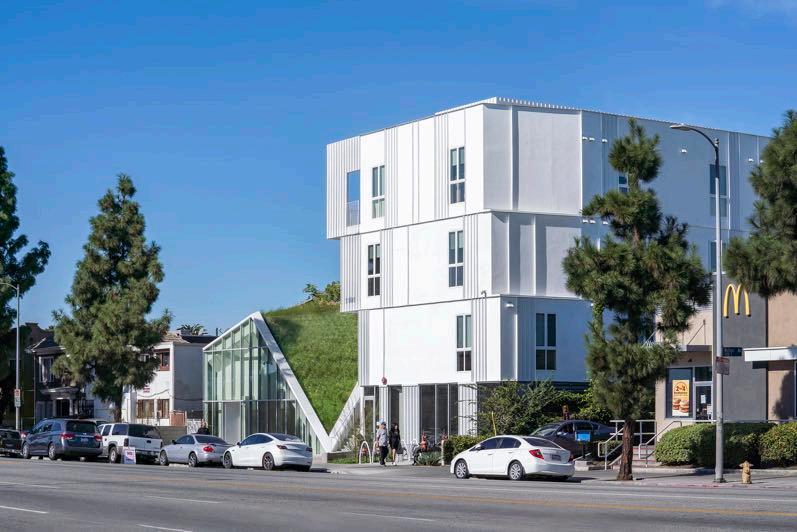
2 minute read
SOCIAL EQUITY
Respondingtoanurgentneed inLosAngelesforhousing cateredtoformerlyhomeless veteransandchronically homelessandlow-income households, LOHAcollaborated withCliffordBeersHousingto transformavacant, unimprovedlotinSouthLA intoa 100% affordablehousing community.

Advertisement




LOHA’s LEED Gold design for this project aims to create an environment that encourages health and community, acknowledging that successful social spaces come through a variety of planned and organic strategies. LOHA incorporates several design strategies that open the building towards the street and foster a sense of community within the neighborhood. Priori-zing social equity, health, and well-being of residents over isola-on, we opted for an L-shaped typology that allows every apartment to receive sunlight and cross ven-la-on, reducing the need for hea-ng, cooling, and ar-ficial light, and allowing for the inclusion of an elevated green pa-o for residents to relax and socialize away from the noise of the street. This building employs the latest strategies in environmentally responsible, forward-thinking green design to maximize space and benefit the en-re community. The building was cer-fied LEED Gold and features include high-efficiency hea-ng and cooling, appliances and fixtures, solar water hea-ng, electric vehicle charging and bike parking. At the street level LOHA’s design capitalizes on a requirement for on-site parking by crea-ng an elevated community garden and social hub for residents and neighbors, that sits atop the street level parking. In order to establish a street presence, the parking is tucked behind a storefront space and a widened staircase that connects the street to the community spaces one level up. This stoop is a gathering space and a public gesture, encouraging the types of resident and neighborhood interac-on oqen missing in suppor-ng housing. The goal of the two retail units at the street level, is to generate income that will help subsidize the housing while providing workforce training to residents so that they can transi-on back into society.
The units are designed for individuals and families, ranging in size from one to three bedrooms each with their own bathroom, and all are equipped with kitchens and living spaces. Tenants are encouraged to use the shared ameni-es in the community room, which has shared kitchen and dining areas for cooking classes, potlucks, group therapy, and other planned / impromptu gatherings.



An outdoor garden with drought-tolerant plants and raised-bed edible gardens connects the community room to the living spaces, giving residents a place to relax and socialize. All the units are accessed through exterior walkways. While the unit layouts are efficiently identical on each floor, the walkways vary in width for a more dynamic, staggered elevation and to create more informal gathering spaces and opportunities for residents to socialize. Further advancing previous experience working with Clifford Beers Housing and other supportive housing organizations like the Skid Row Housing Trust, LOHA’s design acknowledges the successful track record these housing complexes have had with integrating various populations, bringing supportive services in-house, and creating uplifting living environments for people to thrive.









